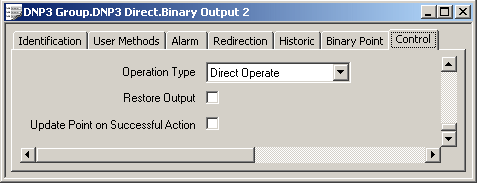NOTE: This section does not apply to output points that are controlled exclusively by another application, rather than ClearSCADA. (For further information, see Specify Whether an Output Point is Controlled by ClearSCADA.)
These fields are displayed toward the bottom of the Control tab on the DNP3 Analog Output Point and DNP3 Binary Output Point Forms. For output points that can be controlled by ClearSCADA, use the fields to specify the type of control and whether ClearSCADA is to restore the point value in the event of power loss:

- Operation Type—Use this combo box to specify which DNP3 control action ClearSCADA is to issue to the outstation, in order to set the value of the point. Choose from:
- Direct Operate—ClearSCADA issues a DNP3 Direct Operate request, and expects the outstation to acknowledge the request.
- Direct Operate - No ACK—ClearSCADA issues a DNP3 Direct Operate, and does not expect the outstation to acknowledge the request.
- Select Before Operate—ClearSCADA issues a two-phase Select/Operate control to the outstation. ClearSCADA has to receive a valid response to the Select before it will issue the Operate.
If the point is on a DNP3 Slave outstation, you use the DNP3 tab on the DNP3 Slave Outstation Form to specify a suitable Select-Before-Operate Timeout for such a request (see Configure the General DNP3 Properties).
- Restore Output—If the outstation’s internal indications indicate that the outstation has restarted (for example, following power failure, or a manual restart of the outstation), a point’s value is lost. Use the Restore Output check box to define whether, in such a situation, the ClearSCADA server is to restore the point’s value at the outstation to the previous point value. This can help to minimize data loss.
Select the check box if ClearSCADA is to issue a control to the outstation, if the outstation's DNP3 device restarted internal indication bit is set. The control sets the value of the point to the last known value stored in the ClearSCADA database. This might be the last read value, or the last controlled point value (if the Update Point on Successful Action check box is also selected on the Control tab). (The value written by ClearSCADA may not be the last ‘control’ value issued by an operator (or by a logic program in ClearSCADA). If ClearSCADA receives an update to the point’s value, through an integrity poll for example, the control issued to the outstation to restore the point’s value will contain the last value reported by the outstation.)
Clear the Restore Output check box if you do not want ClearSCADA to restore the point value in the outstation to the last known value (when the outstation's DNP3 device restarted internal indication bit is set).
- Update Point on Successful Action—Select this check box for the point’s value in the ClearSCADA database to be updated as soon as ClearSCADA receives a response from the outstation, indicating that a control was successful.
Clear the check box to stop ClearSCADA from updating the point when a successful control has occurred. ClearSCADA will update the point’s value in the ClearSCADA database only when the outstation returns the point’s value, for example in a poll response.
In addition to the above, this DNP3-specific field is displayed on the Control tab of DNP3 Analog Output Points:

- Control Object—Use this combo box to specify the format in which ClearSCADA sends the analog point’s value to the DNP3 outstation.
Choose from:
- 32-bit Analog (g41v1)—The control value of an analog output point is sent as a signed, 32-bit integer with status (quality) flags.
- 16-bit Analog (g41v2)—The control value of an analog output point is sent as a signed, 16-bit integer with status (quality) flags.
- Single-precision float (g41v3)—The control value of an analog output point is sent as a signed, IEEE single-precision (32-bit) floating point number with status (quality) flags.
- Double-precision float (g41v4)—The control value of an analog output point is sent as a signed, IEEE double-precision (64-bit) floating point number with status (quality) flags.